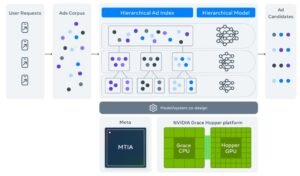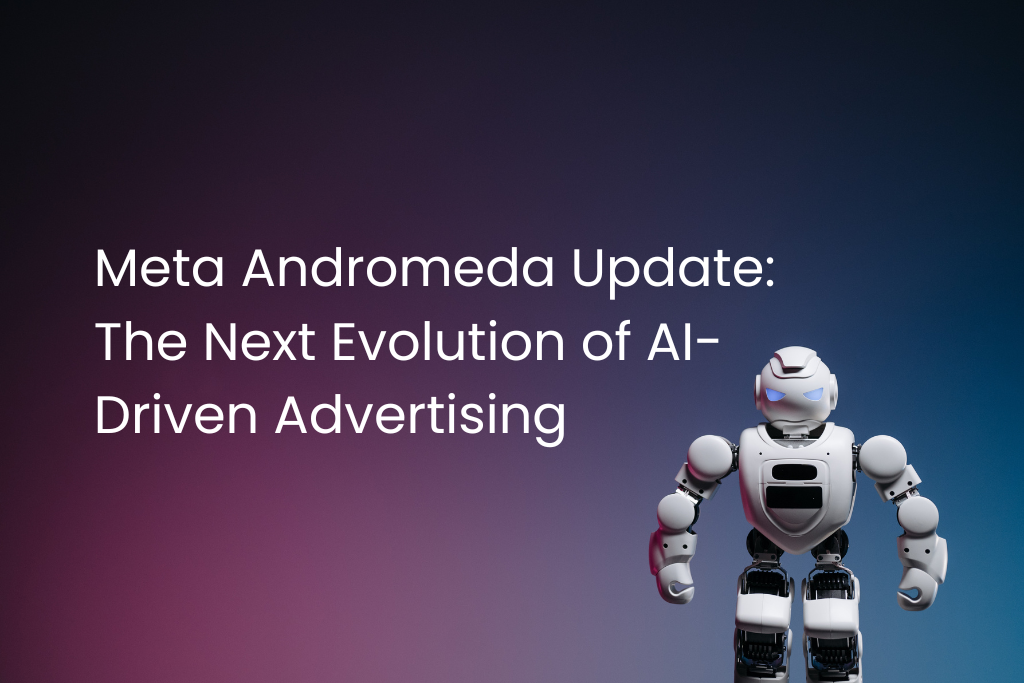Understanding the Meta Andromeda Update – A New Era of AI-Powered Advertising
What is Meta Andromeda?
Meta Andromeda was at first a tool, but then it was an entire rethinking of the way Meta’s ad system pulls out and supplies ads. The engineering team at Meta pronounced it a “personalized ads retrieval engine”, which means that Andromeda has been empowered to get through the huge number of ad candidates and render them to the right users at the right time.
Meta Andromeda, essentially, is a combination of powerful AI and high-end hardware that consists of the NVIDIA Grace Hopper Superchip to deliver ad-user matching at great speed. The company’s new hierarchical indexing system allows it to handle large volumes of ad content more quickly and efficiently.
In short, Andromeda shifts from human audience targeting to AI-powered automation. The matching and optimisation are now handled by Meta’s system; all you have to do is provide high-quality creatives and data. You no longer need to choose audiences and bids for yourself.

Why This Update Matters
The importance of this update can be summarized in a few major points:
- Better Performance: According to Meta, Andromeda optimizes advertisement delivery and quality, leading to a recall increase of 6% and an ad selection improvement of 8%.
- Data Management: With millions of ad creatives, formats, and user signals, manual targeting has become outdated. Even AI can’t handle Andromeda because it is so big.
- Marketers’ New Role: Rather than manually creating numerous ad sets and targeting, marketers now provide high-quality creatives and let AI do the optimization as the main task.
- Winning of Early Adopters: Quick adaptation to the AI system of Andromeda will give businesses an advantage, while those that continue to rely on traditional methods may lag.
All in all, this is not just a simple change—it is a “game-changer” regarding the serving of ads on Meta’s platforms.
Changes in Practice
What’s the difference now when you advertise under Andromeda? Here are the key changes:
- Less Manual Targeting: Wide targeting is the preference here. Let Meta AI do the audience selection, and do it the manual way instead.
- Creative Variety: A Mix of various versions of images, videos, and messages is recommended. Experts suggest 20-50 creatives per campaign, while Meta provides the ability to use up to 150.
- Simpler Campaigns: It is easier to manage fewer campaigns and ad sets. An often complex setup can be outperformed by a single campaign with many creatives.
- Faster AI Optimisation: The system reallocates the budget among the ads in real-time according to which one is performing best. You will need to check for results frequently, but your control over the process will be less.
- From “Who” to “What”: Instead of focusing on the audience, the emphasis is now on presenting the right creative. It is now strong and compelling content that makes the biggest difference.
What This Means for You / Marketers
If you are managing ads on the Meta platforms (Facebook, Instagram), here is how you should change your mind:
- Attribution of a large number of quality feeds: Be certain that you have a constant supply of creative assets. Change format, tone, story, and hook. The system is happy when there are options.
- Make your campaign structure simpler: Use a smaller number of campaigns and ad sets; let AI come up with the audience and the promotion that is best suited, rather than going for lots of tiny segments.
- Keep track of significant events and data: Be certain that the conversion tracking is clean (by means of Meta’s Events Manager/Conversions API) so that the algorithm can learn progressively from reliable signals.
- Do rapid testing and refreshing: Creatives get tired quicker nowadays. The effective cycle may be 7-14 days as suggested. Always include new creatives.
- Allow less manual control but keep strategy supervision: Although you will lose some detailed rule-based optimisations, you will still need to keep an eye on performance, frequency, creative fatigue, and brand consistency.
- Be aware that old strategies might not perform well: If you are employing a lot of interest-based targeting, numerous ad sets, and many manual rules, you are most probably fighting the algorithm instead of working with it. One test showed that combined structures led to a 17 % increase in conversions while cost decreased by 16 %.
Challenges & Considerations
The transition to this new phase is accompanied by certain difficulties:
- Creative bottleneck: The production of more assets will consequently lead to more design and copywriting, and papering over the variations. The brands that have limited creative resources will definitely have a tough time.
- Granular control is lost: At least some of the advertisers do not prefer letting go of control. If your brand needs such precise segmentation, then the general method might be a little uncomfortable for you at the beginning.
- Quality of data is the key: If the conversion data you have is inconsistent, constrained by privacy, or the audience signal is weak, then Andromeda is not going to give you a good performance.
- Transition pains: Some brands report bizarre budget shifts and unpredictable performance as a part of their rollout phase.
- Branding risk: If the creatives of your brand completely emphasize performance hooks and ignore the brand voice, then it is possible that the brand would lose its long-term equity even if the short-term conversions look good.
The Takeaway
Meta’s Andromeda update marks the turning point in the evolution of digital advertising. It puts an end to several manual tactics, such as micro audience segmentation, excessive ad sets, and rule-based budget shifting, and together with AI-first ad retrieval, it brings about a heavier creative focus and structural simplicity.
The advertisers take the message as very clear: either adapt or risk falling behind. Feed the AI by providing it with strong creatives, clean data, and broad targeting. Reorganize your campaigns in a way that the algorithm gets to do its job. Monitor the outcomes that matter. And keep your creative engine refreshed consistently.
If you come to this with a “let’s work with the system” attitude rather than a “let’s fight the system” one, then most probably, you will thrive in the Andromeda era.



